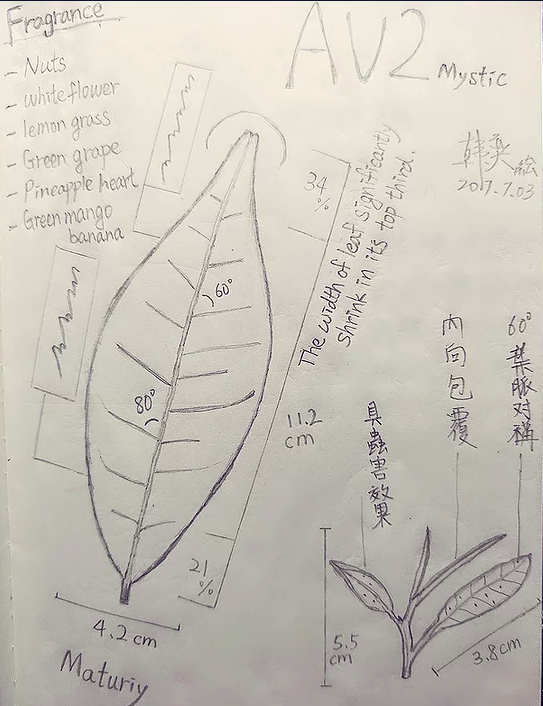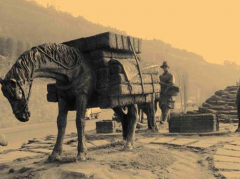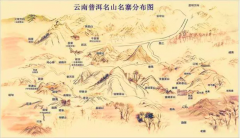What is the difference of Darjeeling Ancient Tree Black Tea? flavor and appearance characteristics of Darjeeling AV2 tea varieties
There is a great difference in the smell between Pu'er and black tea, because the flavor created by the varieties and techniques of ancient tea, old tea and big tea advertised in Pu'er will be relatively calm, heavy, wood-based and full-bodied, and sometimes with juniper, ginseng, plum, jujube, medicinal and soil flavor after transformation.
The raw tea of Pu'er, that is, the green tea with large leaves, tends to show the aroma of smoke, moss, branches, herbs, flowers and fruits, but even if the raw tea has a fresh taste, it will also turn to a calm woody tone after aging.

Of course, the modern new process of Pu'er is a combination of oolong and white tea, and Pu'er tea, which is influenced by the technology of Fujian or Taiwan, is more likely to be rich in floral notes, but most of the big leaves of ancient tea trees are rich in material and have a strong sense of irritation. so it's not necessarily tasting when it's fresh.
Black tea regardless of small leaf species and large leaf species are due to heavy wilting and withering water, heavy fermentation oxidation, heavy kneading and release, transforming tea irritants into softness and gentleness, taste more stable and balanced with sweet carbohydrates and honey, aromas ranging from light white stalks, yellow stamens, orange cores and safflower to slowly ripening temperate green fruits, tree fruits, berries, citrus, peaches, plums, pears, grapes, and even tropical fruits and brewing aromas. It is more suitable to drink when it is fresh, but it will gradually lose the advantages of rich aroma and varied taste of black tea after a long time of transformation.
At present, the Darjeeling DARJEELING area, in addition to the old century-old Chinese trees, will produce variety characteristics due to the clustering of local differences.
After a hundred years of growth in Darjeeling, it has changed too much after localization. On the contrary, AV2, a mainstream variety cultivated by the Indian Tea Bureau, has become a common variety of local black tea as a single variety of asexual reproduction and planting in large quantities. The tea is slender and has a nutty, strong floral, grape and fruit flavor.

[Darjeeling tea variety AV2]
Darjeeling in India has a special soil fertility, which is an ancient seafloor sedimentary rock. The fine and stable soil quality of alpine minerals promotes Chinese tea trees to take root in the ground, and the breeding offspring of Clonal have more abundant details.
Common estates in ✔: Arya, Turzum, Castelton
✔ flavor: Frost sweet yellow lemon, green musk grape, lemon grass, pineapple heart fragrance, mountain banana peel
Some producing areas of ✔ have cashew nuts, nutty flavor and cocoa skins.
✔ organic farming method has obvious insect pests.
The leaf of ✔ is narrow in front and wide behind, and its thickness is thinner than that of other varieties.
The leaf margin of ✔ is wide at the front and back, and the spacing becomes larger.
✔ common names: moonlight, moon ripples, diamonds, legends
Important Notice :
前街咖啡 FrontStreet Coffee has moved to new addredd:
FrontStreet Coffee Address: 315,Donghua East Road,GuangZhou
Tel:020 38364473
- Prev

Is the tea better new tea or old tea? What's the difference in flavor between new tea and old tea?
In the cultural system of drinking tea in the West, we mainly drink new tea, while in the oriental Chinese cultural system, we will discuss the storage of tea over the years. The early stage of importing tea in Europe began in the era of geographical discovery. in the early 17th century, the Dutch East India Company imported Chinese tea and established a trade network in the far East. The goods of Chinese businessmen at that time were given to the East India Company.
- Next

The local flavor characteristics of tea variety P312 in Darjeeling, India are different from those of old tea in Xishuangbanna, Yunnan.
On the other hand, Yunnan is mostly caused by natural growth of tea and seedlings, and there are some differences among individuals and community commonality. For example, in the six major tea mountains in Xishuangbanna, the producing area of Yiwuzheng Mountain is mostly sweet tea, which tastes soft, so Yiwu is the latter, while in the new six tea mountains in Menghai, Jingmai, Brown, Banzhang and Nannuo are Kudi tea and are called Wang. But Darjeeling
Related
- Beginners will see the "Coffee pull flower" guide!
- What is the difference between ice blog purified milk and ordinary milk coffee?
- Why is the Philippines the largest producer of crops in Liberia?
- For coffee extraction, should the fine powder be retained?
- How does extracted espresso fill pressed powder? How much strength does it take to press the powder?
- How to make jasmine cold extract coffee? Is the jasmine + latte good?
- Will this little toy really make the coffee taste better? How does Lily Drip affect coffee extraction?
- Will the action of slapping the filter cup also affect coffee extraction?
- What's the difference between powder-to-water ratio and powder-to-liquid ratio?
- What is the Ethiopian local species? What does it have to do with Heirloom native species?

